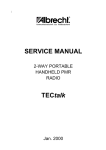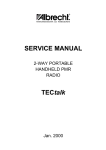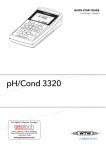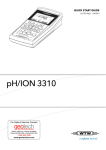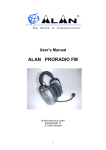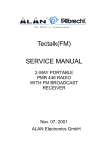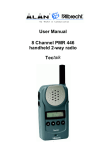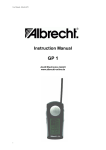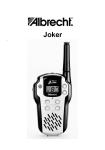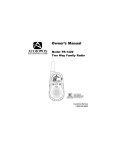Download ALAN Electronics Tectalk FM PMR 446 User manual
Transcript
Tectalk(FM) USER MANUAL 2-WAY PORTABLE PMR 446 RADIO WITH FM BROADCAST RECEIVER ALAN Electronics GmbH CONTENT 1. GENERAL 1.1 General 1.2 Characteristic 1.3 Composition 2. SPECIFICATION 2.1 General Specification 2.2 Electrical Specification 3. OPERATION 3.1 Drawings of the radio 3.2 ICONS on LCD 3.3 Key Functions 3.4 Setting and Operation 4. CHANNEL DATA (With Sub-Channel data) 1. GENERAL 1.1 GENERAL This equipment, Tectalk(FM) is called 2 way PMR 446 portable handheld radios. The frequency range is 446.00625 ~ 446.09375MHz, UHF operating Channels for European PMR 446 2 way portable radios. Also, this unit have built-in FM Radio which receives FM Broadcast Radio frequencies in the 87.5 ~ 108MHz band. 1.2 CHARACTERISTIC a) All active device in this radio is composed of semiconductor and high density IC. b) To design this radio in compact and weight approximately 130g including battery. C) CPU of this equipment is HD404889 from HITACHI. d) You can use PMR 446 and FM Radio with this unit at the same time. e) It's power can operate by use of ALCALINE 4 cell(1.5V AAA) battery 1.3 COMPOSITION This radio is composed of following. a) Transmitter(W/Antenna) b) Belt clip 2. SPECIFICATION 2.1 GENERAL SPECIFICATIONS a) Frequency Range : 446.00625 to 446.09375 MHz b) Output Impedance : 50 Ohms (internal) unbalanced c) Modulation Type : 8K50F3E d) Communication Mode : Simplex e) Channel Capacity : 8 channel f) Channel spacing : 12.5 KHz g) Power : 6.0V(Alkaline) h) Battery Life : Alcaline 1000mAh > about 35hours NI-MH 600mAh > about 22hours ( Tx5%, Rx5%, Stand-by 90% ) i) Operating Temperature : -20°C to +55 °C j) Dimension : 95.5(H)x 50(W)x 26(D)mm k) Weight : 130g(with Battery) 2.2 ELECTRICAL SPECIFICATION a) TRANSMITTER 1) Output power : Max. 0.5 W 2) Frequency Stability : +/- 5 ppm(-20°C to +55°C) 3) Modulation Method : FM 4) Oscillation Method : PLL SYNTHESIZER 5) Max. Frequency Deviation : < +/- 2.5 KHz (with tone) 6) Cooling Method : air-cooling Method 7) Spurious Emission TX: < -36dBm 8) FM Hum/Noise : > 40dB(1kHz 60% modulation) 9) Distortion : < 5% (1kHz 60% modulation) 10) Tx Audio Response : 6dB /OCT +/- 3dB preemphasis (300Hz to 2.5kHz) b) RECEIVER 1) Receive Method : Double Super Heterodyne 2) Receive Sensitivity : -118dBm up (20dB SINAD W/CCITT) 3) Squelch Sensitivity : -120dBm to -130dBm (AUDIO On/Off Point) 4) Bandwidth : > 8.5KHz 5) Selectivity : > 55dB 6) Local Frequency Stability : +/-5ppm(-20°C to +55°C) 7) Spurious Response Rejection : > 65dB 8) Audio output : 200mW (8 Ohms load THD 10%) 9) Distortion : < 5% (1kHz 60% Modulation) 10) RX Audio Response : 6dB/OCT +1/-10dB deemphasis (300Hz -2.5kHz) 11) S/N Ratio : < 40dB(1kHz 60% Modulation) 12) IF : 1'st IF = 21.7MHz 2'nd IF = 450kHz 13) Local Frequency : 1’st Local Frequency = fc - 21.7MHz 2’nd Local Frequency = 21.25MHz c) FM Broadcast Radio 1) Receive Method : Heterodyne 2) Receive Sensitivity : Min –90dBm(12dB SINAD) 3) Local Frequency : 1’st Local Frequency = fc – 75KHz 3. OPERATION 3.1 Drawings of the radio FUNCTIONS AND CONTROLS 1) Battery Door 2) Monitor Button 3) Detachable Belt Clip 4) Push-To-Talk (PTT) Button 5) Antenna 6) External MIC / Speaker 7) Built-in Speaker 8) LCD Panel 9) Built-in Microphone 10) UP Button & Volume Control 11) DOWN Button & Volume Control 12) Function Button 13) Power On/Off & Enter Button 3.2 ICONS on LCD 1. RSSI (Receiving Signal Strength Indicator) or TX Bar Icon Indicates the receiving signal strength during transmission and it can be indicated the number of bar according to the strength of receiving signal. 2) Monitor Indicator Appears when the monitor button is used. 3) CTCSS Indicator Blinks when the correct CTCSS tone is entered. 4) Auto Channel Scan Indicator Appears in the normal scan mode or when the normal scan mode is activated. 5) Priority Scan Indicator Appears in priority scan mode or when the priority scan mode is activated. 6) VOX Indicator Blinks in VOX selection mode or appears when VOX is activated. 7) Key Lock Indicator Blinks in auto lock selection mode or when the key lock is activated. 8) FM RADIO Mode Indicator This icon appears when the FM RADIO is selected. 9) Battery Level Indicator Battery Level Meter indicates the remaining battery strength. 10) Tx Indicator Appears when a signal is being transmitted. 11) Rx Indicator Appears when a signal is being received. 12) Large Segment Display Indicates the channel number in use at the normal mode. When the Function Button is pressed, it Displays the function menu in sequence: Ch / rdo / Sc / Uo / H00 / Sub / CAL / bEP / rog / tAL / [1] / [2] / [3] / P1 / P2 / P3 / P4 / P5 13) Small Segment Display Displays the FM frequency at the FM mode. Displays the SUBMENU of each MENU in the function mode. 13.1 Main Menu CH: 1~8 , 0-38 (ctcss channels) rdo : OFF, ONLY, PLUS SC : nr, Pr(1-8), OFF VO : Hi, nr, Lo, OFF / 1, 2, 3, 5 sec (Vox Delay Time) H00 : 00-99, 00-99 13.2 Sub Menu Sub : yES, NO CAL : 1-7, OFF bEP : On, OFF rog : On, OFF tAL : On, OFF [1],[2],[3]: 1-8, 1-38 P1,P2,P3,P4,P5 : 87.5-108 3.3 Key Functions 3.3-1 POWER ON/OFF & SHIFT BUTTON (#13) 1) Short Touch - Power On a) When FM RADIO is OFF Press this button (#13) briefly to turn the unit on. A short confirming melody will play. A momentary press of this button is not effected to any function in the Function edit mode and stand-by mode except in the specific mode. b) When FM radio is on Pressing this button allows you to shift to next preset FM radio Broadcasting. 2) Long Touch - Power Off Press this button (#13) for longer than 1.5 seconds to turn the unit off. A momentary press of this button is also used to shift to the other small segment display during the function edit mode and reset the stopwatch counter in the stopwatch mode. 3.3-2 FUNCTION BUTTON (#12) 1) Short Touch - Press this button briefly to enter function edit mode in standby mode. 2) Long Touch - Press for longer than 1.5 seconds to activate the KEY LOCK in the standby mode. Please note all buttons will be disabled except the Monitor Button (#2) and PTT Button (#4) will remain fully operational. 3.3-3 UP BUTTON (#10) 1) Short Touch - In the standby mode, press this button briefly to move to the next higher main volume level. - In the function edit mode, press briefly to shift from the current option in each submenu to the next option in the same submenu. 2) Long Touch - Pressing this button for more than 1.5 seconds will allow you to navigate at a more rapid rate through different volume level in the standby mode or through different menus in the function edit mode. 3.3-4 DOWN BUTTON (#11) 1) Short Touch - In the standby mode, press this button briefly to move to the previous lower main volume level. In the function edit mode, press briefly to shift from the current option in each submenu to the previous option in the same submenu. 2) Long Touch - Pressing this button for more than 1.5 seconds will allow you to navigate at a more rapid rate through different volume level in the standby mode or through different menus in the function edit mode. 3.3-5 PUSH-TO-TALK (PTT) BUTTON (#4) - Press it firmly and speak into the Built-in Microphone (#9) to transmit. The red Tx LED Indicator at the right side of the LCD Panel (#8) will light. - Release it to revert to standby mode. When an incoming call is received, the green Rx LED Indicator on the left side of the LCD Panel (#8) will light. 2-Way Call Ringer Press the PTT Button twice quickly to call another party on the same channel and pressing the button once during and pressing the button once during a calling stops the calling and then returns to the standby mode. The user selected call ringer melody will play. 3.3-6 MONITOR BUTTON (#2) - Press it to check activity on the current channel before you try to transmit. - Adjust the Volume Control (#10, #11) if necessary. - When you press the Monitor Button, the LCD Panel (#8) will be illuminated with an amber color back-light and both the Tx and Rx LED Indicators will light. - If you press and hold the monitor button for more than 3 seconds, the monitor appears on the LCD panel and monitor the receiving signal continuously. - To stop the monitoring press the Monitor Button (#2) and return to the standby mode. Press it to confirm the required option for respective functions during function edit mode. 3.3-7 EXTERNAL MIC/SPEAKER (#6) - This jack accepts an optional headset/microphone for handsfree operation. - Please refer to the Albrecht catalogue or homepage to see the variety of available accessories. See also section regarding VOX SELECTION MODE. 3.4 Setting and Operation 3.4-1 CHANNEL SELECTION 1) BASIC CHANNEL SELECTION In order to communicate with other PMR units, both you and the receiving party must be on the same channel. Tectalk FM has 8 channels (1-8) as indicated by the large digits in the LCD Display Panel (#8). Before, trying to transmit on the selected channel, you should press the Monitor Button (#2) to check the activity on that channel.If someone is already on the selected channel, you should try another channel that is clear.To change the basic channel, In the standby mode, press the Up Button (#10) briefly to move to the next higher main channel number. Press the Down Button (#11) briefly to move to the next lower main channel number. Press the Monitor Button (#2) to return to standby mode. 2) CTCSS (Coded Tone Controlled Squelch System) SUB-CHANNEL SELECTION MODE This feature allows you to utilize a less used channel range (00-38) within a main channel. This enables you to communicate with another party on the same main channel using the same subcode. This helps to avoid congestion on the main channel and filters out unwanted noise and static. There are 38 CTCSS sub-channels for each main channel. To change the CTCSS sub-channel, -press the Function Button (#12) until the word “Ch” appears in the LCD Panel (#8). -Press the Shift Button (#13) and the two small number on the right side will blink on the LCD Panel (#8). - Press the Down Button (#11) or the Up Button (#10) to choose the desired sub-channel to use. - The corresponding sub-code frequency will be displayed in the lower right corner. - Press the Monitor Button (#2) to confirm your selection and return to standby mode. NOTE: To communicate with other PMR units, they must be switched to the same channel and CTCSS sub-code. To communicate with other PMR units that do not have sub-codes, switch your unit to the same channel with the sub-code set to OFF. 3.4-2 FM RADIO Mode 1) FM Only : You can receive the FM Radio only 2) FM plus : You can receive the FRS signal even while you listen to the FM Radio. 3) When the FM only or FM plus is selected on the FM selection mode, FM icon( )appears on LCD Panel (#8). And you can choose the channel by pressing the Up Button (#10) and the Down Button (#11). 4) When the FM only or FM plus is selected on the FM selection, you can select the way of channel selection in seek scan and tune scan by pressing the Enter Button (#13). 5) If you select seek scan, you can select the FM radio channel by carrier detect way and if you select tune scan you can select the FM radio channel 3.4-3 CHANNEL SCAN MODE 1) NORMAL SCAN MODE This feature allows you to scan for an active channel and communicate with the party transmitting. The power saver is disabled in this mode. To access the Auto Channel Scan menu, Press the Function Button (#12) until the word “SC” appears in the LCD. - Press the Down Button (#11) or the Up Button (#10) to choose “nr”. - Press the Monitor Button (#2) to confirm your selection. The unit will begin scanning for an active main channel. If a transmission is detected, the Rx and RSSI icons will appear in the LCD Panel (#8). To turn off the auto channel scan feature return to the Scan mode by pressing the Function Button (#12) and choose ”OFF”. You can pause on any channel while in the Auto Channel Scan Mode by pressing the the PTT Button (#4) during the reception of a signal for 5 seconds afterward. Pressing the Monitor Button (#2) will resume scanning and eliminate that channel from those being scanned. 2) PRIORITY SCAN MODE This feature allows you to monitor two different channels at the same time. If you pre-set any priority channel other than the current channel in use, the pre-set channel will be scanned every 0.5 second and signals you when a call is received. While in the Priority Channel Scan Mode you may hear transmission from either a primary or secondary channel when transmitting. The unit will always transmit on the primary channel unless the PTT Button (#4) is pressed during or immediately following the reception of secondary channel transmission. The power saver mode is disabled in the Priority channel scan mode and the volume is not adjustable. To access the Priority channel scan mode. - Press the Function Button (#12) until the word “SC” appears in the LCD Panel (#8). - Press the Up Button (#10) or the Down Button (#11) to choose “Pr” and then press the Shift Button (#13). - Choose the priority channel by pressing Up Button (#10) and Down Button (#11) to select the desired channel number you wish to closely monitor. - Press the Monitor Button (#2) to confirm your selection. -To turn off the Priority channel scan feature, press the Function Button (#12) until the word “SC” appears on the LCD Panel (#8) and then choose “OFF” in the scan mode. 3.4-4 VOX & VOX RECOVERY TIME SELECTION MODE 1) VOX SELECTION MODE The Voice Activated Transmission (VOX) function allows your voice to activate transmission automatically when the TECTALK FM is used with the optional Handsfree MIC/headset. It also allows Handsfree use when a MIC/headset is not being used without having to use the PTT Button (#4). To access the VOX Selection menu, - Press the Function Button (#12) until the word “UO” appears in the LCD Panel (#8). - Press the Down Button (#11) or the Up Button (#10) to select from Hi, nr, Lo or OFF. - The High, normal or low setting determines VOX response sensitivity. - Press the Monitor Button (#2) to confirm your selection. - To turn off the VOX feature, enter the VOX selection mode and then select OFF. 2) VOX RECOVERY TIME SELECTION MODE This allows the response characteristics of the VOX function to be precisely adjusted to suit individual needs. To access the VOX Recovery Time Selection menu, - Press the Function Button (#12) until the word “UO” appears in the LCD Panel (#8). - Press the Power/Shift Button (#13) to confirm your selection and switch to VOX recovery time selection. - Press the Down Button (#11) or the Up Button (#10) to select from 5, 3, 2 or 1 second setting. This setting determines the delay time between transmitting and receiving. - Press the Monitor Button (#2) to confirm your selection. Please note you may need to try different VOX time settings to determine the best value to suit your speaking habit. 3.4-5 STOPWATCH MODE In this mode you can use the stopwatch to time. To access the Stopwatch mode : - Press the Function Button (#12) until the word “H00” appears on the LCD Panel (#8). - Press the Up Button (#11) to start and stop the counter up while the stopwatch is running, pressing the Down Button (#11) allows you to obtain the lap time. - Press the Power/Enter Button (#13) to reset the stopwatch time. - Press the Function Button (#12) to turn off the stopwatch function. 3.4-6 SUB OPTION SELECTION MODE This mode allows you to enter the sub option selection mode. -Press the Function Button (#12) until the word “Sub” appears in the LCD. You can now select between “yes” or “No”. -If you press the Function Button (#12) when “yes” blinks on the LCD Panel (#8), you enter into the Sub Function edit menu. - Pressing the Function Button (#12) when, “no” blinks, returns to standby. Access to following SUB Menu points is only possible when You have avtivated the SUB menu by setting to “Yes” 1) CALL RINGER MELODY SELECTION MODE This feature provides 7 user selectable call ringer melodies to alert you of a calling party. To select your favorite Call Ringer melody, - In the Sub option selection mode, press the Function Button (#12) when the “yes” blinks. - Press the Down Button (#11) or Up Button (#10) to preview the seven available melodies. - Press the Monitor Button (#2) to confirm your selection. 2) BEEP TONE SELECTION MODE This feature allows you to program beeping or not beeping with key selection. If the Key beep off is chosen no beep sound when you press the button The call signal, power on/off beep and roger beep make a sound regardless of the beep. - Press the Function Button (#12) from the Call selection mode. - Press the Up Button (#10) or Down Button (#11) to select from on or off. - Press the Monitor Button (#2) to confirm your selection and return to standby mode. - When you press Enter button (#13) or do not press any key within 5 seconds, it returns back to stand-by. 3) ROGER BEEP SELECTION MODE If Roger Beep option is on, when you finish the transmitting automatically the TECTALK FM will produce a beep sound and transmit a sub-code tone to the partner. To access the Roger Selection Mode : - Press the Function Button (#12) from the Key beep selection mode. - Press the Up Button (#10) or Down Button (#11) to select from Roger on or off. - Press the monitor Button (#2) to confirm your selection and return to standby mode. 4) SQUELCH TAIL SELECTION MODE This feature allows you to set option mode of CTCSS squelch tail elimination. - Press Function Button (#12) at the CTCSS display option mode, You can select On or Off with Up(#10) or Down(#11) button. - When you press Enter Button (#13) or not press any key in 5 seconds, it returns back Stand-by mode with back beep sound after installation squelch tail elimination option its setting. 5) PMR MEMORY CHANNELS SELECTION MODE This feature allows you to preset the frequency and sub code. You can preset the frequencies and sub codes you use frequently. Max. 3 memory channels are possible. To access the Preset selection Mode - Press the Function Button (#12) from the Roger selection Mode. - Press the Up Button (#10) or Down Button (#11) to preset the channel. - Press the Power & Shift Button (#13) to shift into CTCSS code selection option. - Press the Up Button (#10) or Down Button (#11) to preset the CTCSS code desired. - Press the Monitor Button (#2) to return to stand by mode. 6) FM Broadcast Radio Preset 1 to 5 If Your Tectalk FM is programmed to listen to FM broadcast, it is possible to select beween maximum 5 preset radio stations simply by pressing the function button F in the receive mode subsequently (Display shows P 1 to P5). If You have not yet preset Your desired radio stations, enter the SUB Menu first. Select memory location P1 to P5 and select the frequencies with up and down buttons or . Confirm each setting with the memory button M. 4. CHANNEL LIST Channel Frequency MHz 1 446.00625 2 446.01875 3 446.03125 4 446.04375 5 446.05625 6 446.06875 7 446.08125 8 446.09375 CTCSS (Continuous Tone Coded Squelch System) Frequency List Sub Channel Tone Frequency Sub Channel Tone Frequency 1 67.0 Hz 21 136.5 Hz 2 71.9 Hz 22 141.3 Hz 3 74.4 Hz 23 146.2 Hz 4 77.0 Hz 24 151.4 Hz 5 79.7 Hz 25 156.7 Hz 6 82.5 Hz 26 162.2 Hz 7 85.4 Hz 27 167.9 Hz 8 88.5 Hz 28 173.8 Hz 9 91.5 Hz 29 179.9 Hz 10 94.8 Hz 30 186.2 Hz 11 97.4 Hz 31 192.8 Hz 12 100.0 Hz 32 203.5 Hz 13 103.5 Hz 33 210.7 Hz 14 107.2 Hz 34 218.1 Hz 15 110.9 Hz 35 225.7 Hz 16 114.8 Hz 36 233.6 Hz 17 118.8 Hz 37 241.8 Hz 18 123.0 Hz 38 250.3 Hz 19 127.3 Hz 20 131.8 Hz European 2 years warranty The distributor, dealer or retail shop warrants to the original retail purchaser of this product that should this product or any part of it, under normal use and conditions, be proven defective in material or workmanship within 2 years from the date of original purchase, such defect(s) will be repaired or replaced with new or reconditioned product (at the company's option) without charge for parts and repair labor. To obtain repair or replacement within the terms of this warranty, the product is to be delivered with proof of warranty coverage (e.g. dated bill of sale), specification of defect(s), to the distributor, dealer or his authorized repair center. The Company disclaims liability for communications range of this product. The warranty does not apply to any product or part there of which, in the opinion of the company, has suffered or been damaged through alteration, improper installation, mishandling, misuse, neglect, accident, or by removal or defacement of the factory serial number/bar code label(s). The warranty does not apply to accessory parts or problems caused through not authorized or not recommended accessories like of the units like batteries, external power supplies and over voltage caused through external power supplies, light bulbs, broken antennas, broken swivel belt clips, broken or damaged acrylic glass windows and cabinet parts. Please contact the dealer or person where You have purchased Your Tectalk FM. Where to find service hints and documentation The complete technical documentation is updated regularly. You can download the latest versions of user manuals, technical documents and conformity declaration, as well as service hints or FAQ’s any time from our server under http://www.albrecht-online.de/service If You should have a problem, please have a look to the service hints or frequently asked questions (FAQ) before You send Your Tectalk FM back to the service center. CE- Declaration of Conformity Albrecht Tectalk-FM / JDP-408 HF This unit complies to all relevant European Standards and Regulations for PMR 446 radio service. This radio may be used only in EU countries and some other states applying the R&TTE directive of the European Community. However, there are still some restrictions (as of date of this user manual) to use PMR 446 in following countries: Italy and Norway: PMR 446 is not yet established in these countries. Other radio services are still legally using these frequencies. Travellers may take the radios with them, but not operate them. Please ask local authorities for further informations! France: Channels 1 and 2 are not yet allowed to be used. Belgium: No restrictions for travellers using the radio in Belgium free of charge and licence for less than 3 months. Residents of Belgium must apply for a radio operating licence according to Belgian regulations. Eastern Europe Please ask the local authorities before using the radio, because only few countries outside EU apply already the european R&TTE directive. Following countries still apply special national approval regulations, not (yet) valid for PMR 446 radio: Poland, Estonia, Letavia, Lithuania, Ukraine, Russia, Belarus, Slowenia and some others. This unit fully complies to the following European standards: Radio& Spectrum engineering: EN 300 296-2 (2001), EN 55013 +A12, 13, 14 (1990-99) (FM radio part 87.5-108 MHz) Electromagnetic Compatibility (EMC): EN 301 489-0 and EN 301 489-5 (2000), Electrical safety: EN 60 065. The notified body 0681 (ETS) had been involved for the expert’s opinion about the conformity of this radio. The unit is intended to be used in following european (EU and non EU countries): A, B, CH, D, DK, E, F, FIN, GB, GR, H, IS, IR, L, NL, P, S, TR (JDP-408HF) Lütjensee, 13.05.2002 ALAN Electronics GmbH , Dovenkamp 11, D- 22952 Lütjensee Note: The latest actual version of our „EC Declaration of Conformity“ may be downloaded from our Internet server under http://www.albrecht-online.de/service .
















